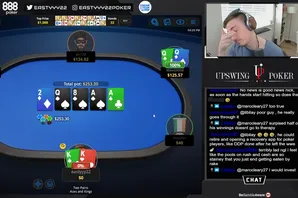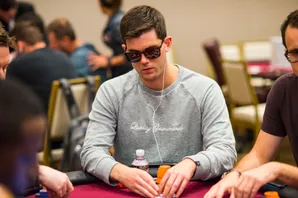You will sometimes hear poker players talking about “levels” of thinking. It’s a way of quantifying how a poker player is thinking about their hand and their opponents’ hands.
-
Level One means the player is simply looking at their cards, ranking their hand on the poker hand scale. It’s how a video poker player sees the world: “I have a straight – that’s really good. I have a flush – that’s better.”
-
Level Two means the player is thinking about what their opponent might have. “I have two pair, which is pretty good. But the way that person is betting suggests they might have three of a kind. So I have to be careful.”
-
Level Three is the next step up, where the player thinks about how their hand must look to their opponent. “I raised preflop and then bet two streets on an ace-high board. This must look like a pair of aces at least.”
-
Level Four raises the stakes even further: “What do they think I think they have?”
Nothing, except wisdom, prevents this cognitive arms race from continuing indefinitely. The truth is, few players get anywhere near this level of analysis. In fact, you often hear poker players talk about “leveling themselves” into bad decisions. That means if you play assuming your opponent is thinking higher up the scale than they actually are, you can end up playing right into their hands.
But when two experts tangle, it’s hard to know where the leveling battle ends.
Take this hand that appeared on YouTube recently. Doug Polk, a legendary player and theoretician, gets into a hand against another extremely skilled player, referred to as “E” in the video.
Here’s how the hand unfolds:
-
E opens to $150 from middle position with 88, gets two callers, and then Doug calls with 44 on the button.
-
The flop comes A-7-4 rainbow, giving Doug bottom set. This is a good flop for E’s range, though not his actual hand. E will have a lot of aces in his opening range, and if nobody else has an ace, he may well take the pot down right there. E bets $200. The other two players fold, but Doug raises to $675, knowing that E is unlikely to fold an ace.
Doug’s perfect world has E holding something like AK, which looks strong but is actually drawing nearly dead. However, E calls the raise.
-
The turn brings an 8, giving E a larger set. Knowing that Doug has shown strength (having raised the flop), E checks. Doug bets $1500 into a $2000 pot. E raises to $4100.
At this point, a Level One player in Doug’s shoes would think, “I have a set!” and likely shove all their chips into the middle. But Doug is already at Level Three. He understands that he’s shown strength by raising the flop and betting the turn. And now E wants to put even more money into the pot.
The commentator, Mike Brady, correctly points out that Doug should be cautious. Doug has the smallest possible set. E could have a set of 7’s, or even a set of aces (since he was the only raiser preflop). There’s also the possibility E has 65 (possibly suited), which flopped an open-end straight draw, bet, called, and then turned the nuts.
Doug decides to see the river card and use his position to gather more information from E. With $10,100 in the pot, the river brings an inconsequential 2h. E shoves his remaining $10,300 in, giving Doug almost exactly 2:1 pot odds to call.
At this point, Doug could level himself up to thinking that E is playing 4-D chess with him. They both know that huge strength has been shown on both sides, and E could be running an audacious bluff simply because Doug is likely aware that E knows Doug is representing the nuts or something close to it.
But Doug’s decision is key. I won’t spoil it by telling you exactly what happens, but I suggest you watch the video and focus on Doug’s thought process rather than the outcome. The final decision was, in essence, a “coin flip,” but Doug’s mental journey to that point is where the real value lies.
Neither you nor I may ever be as skilled as Doug Polk, but we can certainly learn from his approach—especially when to climb the level ladder and when to stop.












